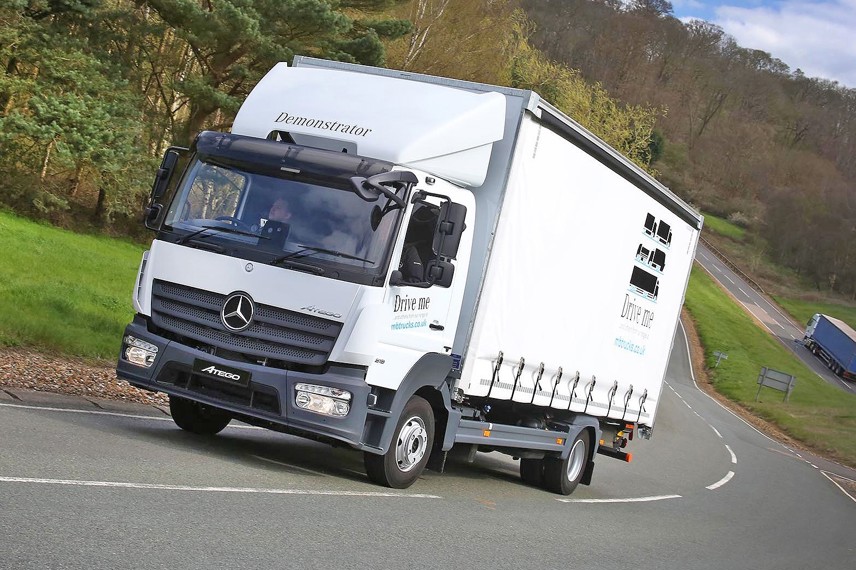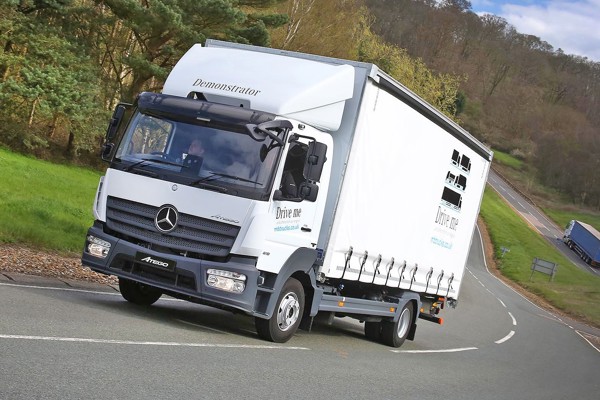Review
It’s been almost 25 years since the first Atego broke cover in 1998 and, since then, we’ve had a number of facelifts and ‘new models’ – three in fact. And the competition in this still popular lightweight 4x2 truck sector has continued to develop in that time.
It’s with this in mind, we thought it maybe worth re-evaluating what the Atego has to offer the 7.5- tonne truck operator.
There are a number of variations available if you consider the different cabs, power settings and wheelbases, not to mention suspension and gearbox options. Taking all this into account, the best selling combination is the 816 day cab that will fit a 20-foot box van, curtainsider or flat.
In the 7.5-tonne range, there are a number of power settings, but the 158PS (115kW) rated at 1,800rpm is maybe the most popular with a torque of 610Nm rated between 1,200-1,600 rpm.
Diesel power is developed by Mercedes-Benz’s own OM934 which is a comparatively large 5.1-litre engine, especially when you see that some competitors are operating at similar powers with a sub-four-litre power plant. The Euro VI D-compliant engine uses selective catalytic reduction and exhaust gas recirculation to help it keep under the more stringent emission standards.
We have seen the replacement of manual gearboxes in favour of automated versions in the heavy truck segment for decades and now this trend is moving further down the weight range; the Atego is no exception. Mercedes-Benz’s own G 70-6/5.90 gearbox, featuring an overdrive 0.74 top gear with its Powershift 3 automated system, is proving to be a popular choice amongst most recent buyers.
A typical distribution box van or curtainsider usually has a body length of approximately 20 feet, and the most appropriate wheelbase looking at the Atego chassis line-up is the 4,820mm. As far as suspension goes it sits on parabolic springs at the front and the same on the rear with the option of air if required. The front axle is rated at 3.6 tonnes and rear five tonnes, giving a load tolerance/latitude of around a tonne, and 215/75R17.5 tyres are fitted all round.
To the left of the chassis is a plastic 180-litre fuel tank supplemented by a 25-litre AdBlue one. As with all commercial vehicles at this weight, the Atego comes with ABS and ESP, the braking system has discs on the front and rear axles. The engine also features an exhaust brake as standard and completing the safety systems are lane-keep assist and active brake assist.
The gross vehicle weight is 7,490kgs and the 4.8m wheelbase with the S day cab weighs 2,761kgs on the front axle and 1,141kgs on the rear making a total kerb weight of 3,902kgs allowing for a payload of 3,588kgs. The gross train weight is 10,990kgs so the vehicle can tow 3,500kgs.
The ClassicSpace S day cab Atego is 2,295mm wide and 1,650mm long externally and 1,510mm inside. There is also an extended version which is 180mm longer.
The relatively low chassis means only one step is needed to enter the cab although this means a tunnel separates driver and passenger. The driver’s seat is suspended whereas the passenger’s is fixed and the cab features a roof hatch/vent, electric mirrors, heated- and electrically-operated mirrors and radio, with USB connection and Bluetooth.
The S cab is a pleasant environment to work in and the Powershift 3 gearbox has an excellent reputation. The combination makes the contemporary Atego a compelling alternative to rivals when payload is not the deciding factor.

















